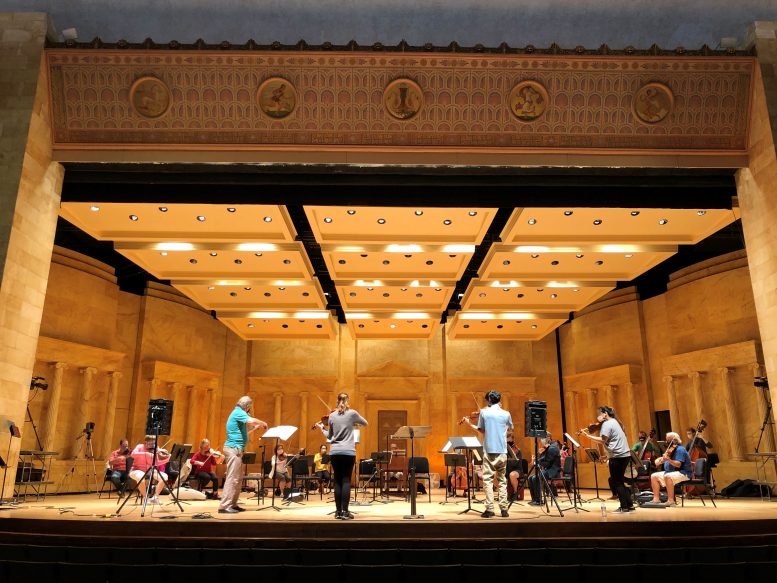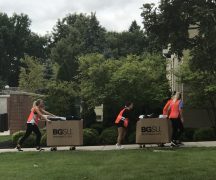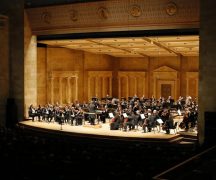By DAVID DUPONT
BG Independent News
The Toledo Symphony Orchestra returns this weekend six months after the pandemic shut down its season.
And the music they play will reflect on how times have changed in those six months.
In sold-out performances this weekend, the orchestra will perform the iconic “Four Seasons” by Antonio Vivaldi and pair it with British composer Max Richter’s “Four Seasons Recomposed.” Sunday’s matinee at 3 p.m. will be live streamed.
The program speaks to this season of pandemic, said Zak Vassar, the orchestra president and CEO. “Max Richter is recreating this storied and wonderful tradition for a 21st century audience.” And like the composition, the orchestra is returning “to the stage in this COVID era to create and continue a tradition in very different circumstances.”
The program also has some very practical benefits, Vassar said.
For one, it does not require a conductor. Instead it will be conducted by the violin soloist, a duty that will be shared by four orchestra musicians – Kirk Toth, Téa Prokes, Merwin Siu, and Gyusun Han.
That’s important because the orchestra music director and conductor Alain Trudel is on the other side of the Canadian border, waylaid by pandemic restrictions, and unavailable for the opening weekend. He is expected to travel to Toledo next week in time for the performances of Beethoven’s “Eroica” Sept. 25 and 26 (also sold out).
The concerts in the fall will be presented in a COVID-19 resistant way. The musicians will wear face coverings. This weekend’s concerts use a string orchestra.
The “Eroica” will use a full complement of winds.
The wind players will be masked except when playing, and all wind instruments except the flutes will be equipped with bell covers, thin nylon devices to inhibit the emission of aerosol droplets.
No more than 40 musicians will be on stage at any given time, all will be spaced at least six feet apart.
“That’s a challenge for the musicians,” Vassar said. “These are folks who are used to sharing a music stand.”
They have to match pitch and tone. “That’s just harder to do in six-foot intervals, especially when they haven’t played in an ensemble since March.”
Back then it was uncertain when the orchestra or other performing arts groups would be able to return.
Many other orchestras and ballet companies decided to wait until early 2021 to resume activities.
But the Toledo Symphony board decided that they could return on schedule, albeit with restrictions.
The state set guidelines that venues may have no more than 15 percent of their capacity in the audience. For the Peristyle that’s 225 people in a hall that holds 1,700.
Vassar said the venue lends itself well to social distancing. It has no balcony, numerous exits and entrances, and wide hallways. So, all concerts will be held there this fall.
It is the orchestra’s “spiritual home,” Vassar said. “Especially given all the success the Toledo Museum of Art has had with their reopening, it really gives us a lot of confidence.”
There will be shorter programs with no intermissions that would present too many opportunities for bottlenecks as people move about. “Let’s face it,” he said, “the Peristyle lobby, as beautiful as it is, is not appropriately sized for social distancing.”
Pairs of listeners will be seated with six feet or more between other parties. Larger parties can sit together if they’re within each other’s bubble, and indicate that when they purchase tickets.
That, however, is a moot point, given all concerts through December sold out quickly.
When the subscribers were approached about the options of attending live concerts or livestreaming performances, “the very quick feedback was they wanted to come back for the live performances,” Vassar said. One woman said she wouldn’t leave her house for the rest of week if she could go to the orchestra.
“That’s just the state of where people are right now.”
The orchestra has also launched a new streaming service, TAPA Streaming.
Vassar credited Allie Dresser, marketing manager, with spearheading the new initiative.
Through the streaming services, listeners will have the option of purchasing a ticket to watch a live performance – Sunday’s concert this weekend, or after the concert dates they can rent a recording of that performance and have access to it for 30 days.
This will enable the symphony to reach those fans who are not able to be in the audience. And possibly reach more listeners, Vassar said.
In March, the orchestra’s final program was streamed over YouTube. Over the few weeks following the performance more than 5,000 people accessed the recording.
“Once we start opening up to that concept of what view at home could look like, we start to realize that in all our efforts to get out in the community and engage with them the one thing we’ve demanded of them is that they come to us,” Vassar said. “Now we have this wonderful software program where we can go to them.”
Since 2015, the orchestra has offered a visual element through high definition screens positioned above either side of the stage that project images of the orchestra as it performs. This is an outgrowth of TSO in HD offering the same quality of videography and same quality of sound, Vassar said, except the listener will be able to rewind, skip forward, pause, and watch when they want. “We put the viewer in control,” he said.
“This has long been an ambition of ours,” Vassar said. “But I don’t know that we would have raced to create it until now just because it wasn’t a pressing priority.”
But with the need to reach beyond those seated in the Peristyle, “it makes sense for us to do it.”
There are multiple barriers keeping people from coming to a concert – mobility and accessibility, the price of tickets, transportation. Streaming brings the orchestra to audiences “that we should have been serving anyways,” he said.
TAPA Streaming will also include programs by the Toledo Ballet, the symphony’s partner in the Toledo Alliance for the Performing Arts, as well as other community performing arts organizations.
The hope is that by spring, the symphony will be able to begin to return to business as usual with concerts at the Valentine, Stranahan, and Toledo Club. A pops concert is scheduled for the Stranahan in February, but can be moved to the Peristyle if necessary.
“We’re hoping at that point we’d have the ability to seat more people on stage, more people in the house and get back to ‘regular programming,’” he said. But at this point, that’s “finger in the air” speculation.
The shutdown has been a financial hit to the symphony, as it has for other arts organizations.
Vassar said the symphony is looking at a 25-30 percent decline in revenues from ticket sales.
Again, the organization is banking on the new streaming. “This experiment is to grow the appetite, not just locally, but nationally for these programs. Any achievements we make along those lines could help balance some of that shortfall.”
Still the orchestra will end the year in the red, he said. “Few arts organizations will be in the black this year, many rarely are in the first place,” he said. “We have a generous board of trustees who are committed to making music here.”
Part of that was making sure it maintained the orchestra. No musicians were furloughed.
“Once you take an organization that’s used to being an ensemble, and thinking and behaving like an ensemble, and start tearing it apart, you never get back to it. It’s something we want to avoid however we can.”
The trustees even will honor “a small raise” that had been negotiated in the collective bargaining agreement.
“We’re one of the few orchestras that were able to do that,” he said, “thanks to the generosity of board and all our supporters who share that vision and understand why it’s important.”





